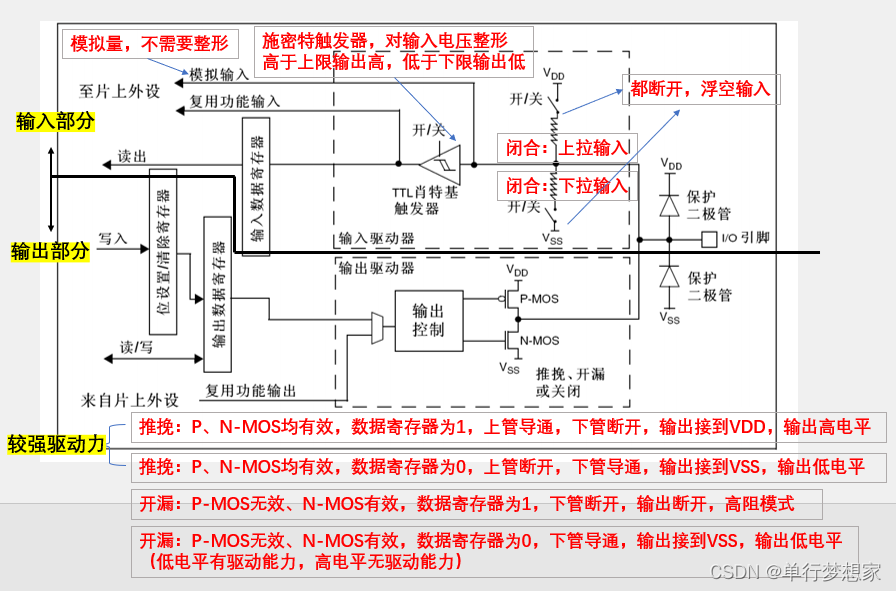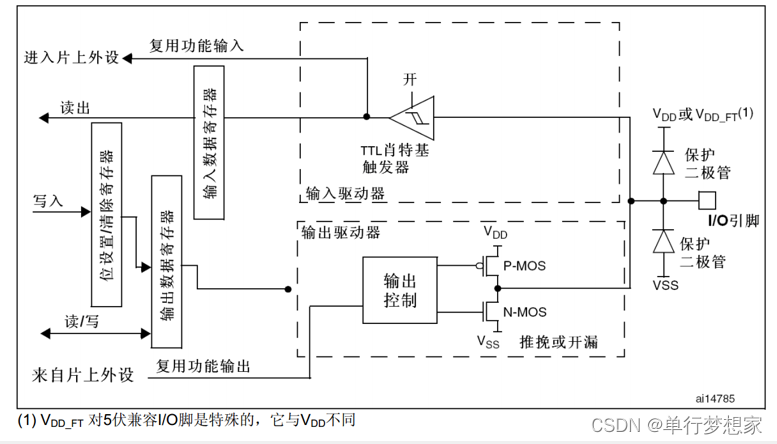一、GPIO简介
·GPIO(General Purpose Input Output)通用输入输出口
·可配置8种输入输出模式
·引脚电平:0V~3.3V,部分引脚可容忍5V
·输出模式下:可控制端口输出高低电平,用以驱动LED、控制蜂鸣器、模拟通信协议输出时序等
·输入模式下:可读取端口的高低电平或电压,用于读取按键输入、外界模块电平信号输入、ADC电压采集、模拟通信协议接收数据等
二、GPIO结构

三、GPIO位结构

四、GPIO模式
4.1 浮空/上拉/下拉输入
(GPIO_Mode_IN_FLOATING/GPIO_Mode_IPU/GPIO_Mode_IPD)

4.2 模拟输入(GPIO_Mode_AIN)
 4.3 开漏/推挽输出
4.3 开漏/推挽输出
(GPIO_Mode_Out_OD/GPIO_Mode_Out_PP)

4.4 复用开漏/推挽输出
(GPIO_Mode_AF_OD/GPIO_Mode_AF_PP)

五、GPIO库函数
void GPIO_DeInit(GPIO_TypeDef* GPIOx);//复位GPIO外设
void GPIO_Init(GPIO_TypeDef* GPIOx, GPIO_InitTypeDef* GPIO_InitStruct);//初始化GPIO
void GPIO_StructInit(GPIO_InitTypeDef* GPIO_InitStruct);//给结构体赋默认值GPIO读取函数
uint8_t GPIO_ReadInputDataBit(GPIO_TypeDef* GPIOx, uint16_t GPIO_Pin);//读取输入数据寄存器某一个端口的输入值
uint16_t GPIO_ReadInputData(GPIO_TypeDef* GPIOx);//读取整个输入数据寄存器,返回一个16位的数据
uint8_t GPIO_ReadOutputDataBit(GPIO_TypeDef* GPIOx, uint16_t GPIO_Pin);//读取输出数据寄存器某一个端口的输入值(输出模式)
uint16_t GPIO_ReadOutputData(GPIO_TypeDef* GPIOx);//读取整个输出数据寄存器
GPIO写入函数
void GPIO_SetBits(GPIO_TypeDef* GPIOx, uint16_t GPIO_Pin);//设置高电平
void GPIO_ResetBits(GPIO_TypeDef* GPIOx, uint16_t GPIO_Pin);//设置低电平
void GPIO_WriteBit(GPIO_TypeDef* GPIOx, uint16_t GPIO_Pin, BitAction BitVal);
void GPIO_Write(GPIO_TypeDef* GPIOx, uint16_t PortVal);void GPIO_PinLockConfig(GPIO_TypeDef* GPIOx, uint16_t GPIO_Pin);
//锁定GPIO配置,防止意外更改
六、实验(GPIO输出)
6.1 LED闪烁
#include "stm32f10x.h" // Device header
#include "Delay.h"int main(void)
{//一、使用RCC开启GPIO时钟RCC_APB2PeriphClockCmd(RCC_APB2Periph_GPIOA,ENABLE);//二、使用GPIO_Init函数初始化GPIOGPIO_InitTypeDef GPIO_InitStructure;GPIO_InitStructure.GPIO_Mode = GPIO_Mode_Out_PP;GPIO_InitStructure.GPIO_Pin = GPIO_Pin_1; GPIO_InitStructure.GPIO_Speed = GPIO_Speed_50MHz;GPIO_Init(GPIOA,&GPIO_InitStructure);while (1){//=====one:GPIO_WriteBit=====//
// GPIO_WriteBit(GPIOA,GPIO_Pin_0,Bit_RESET);
// Delay_ms(500);
// GPIO_WriteBit(GPIOA,GPIO_Pin_0,Bit_SET);
// Delay_ms(500);//=====two:GPIO_WriteBit 0/1=====//
// GPIO_WriteBit(GPIOA,GPIO_Pin_0,(BitAction)0);
// Delay_ms(500);
// GPIO_WriteBit(GPIOA,GPIO_Pin_0,(BitAction)1);
// Delay_ms(500);//=====three:GPIO_ResetBits GPIO_SetBits=====//GPIO_ResetBits(GPIOA,GPIO_Pin_0);Delay_ms(500);GPIO_SetBits(GPIOA,GPIO_Pin_0);Delay_ms(500);}
}
6.2 LED流水灯
#include "stm32f10x.h" // Device header
#include "Delay.h"int main(void)
{RCC_APB2PeriphClockCmd(RCC_APB2Periph_GPIOA,ENABLE);GPIO_InitTypeDef GPIO_InitStructure;GPIO_InitStructure.GPIO_Mode = GPIO_Mode_Out_PP;GPIO_InitStructure.GPIO_Pin = GPIO_Pin_0 | GPIO_Pin_1 | GPIO_Pin_2 | GPIO_Pin_3 | GPIO_Pin_4 | GPIO_Pin_5 | GPIO_Pin_6 | GPIO_Pin_7; //GPIO_InitStructure.GPIO_Pin = GPIO_Pin_All;GPIO_InitStructure.GPIO_Speed = GPIO_Speed_50MHz;GPIO_Init(GPIOA,&GPIO_InitStructure);while (1){GPIO_Write(GPIOA,~0x0001);//0000 0000 0000 0001,PA15-PA0,低电平驱动所以取反Delay_ms(100);GPIO_Write(GPIOA,~0x0002);//0000 0000 0000 0010Delay_ms(100);GPIO_Write(GPIOA,~0x0004);//0000 0000 0000 0100Delay_ms(100);GPIO_Write(GPIOA,~0x0008);//0000 0000 0000 1000Delay_ms(100);GPIO_Write(GPIOA,~0x0010);//0000 0000 0001 0000Delay_ms(100);GPIO_Write(GPIOA,~0x0020);//0000 0000 0010 0000Delay_ms(100);GPIO_Write(GPIOA,~0x0040);//0000 0000 0100 0000Delay_ms(100);GPIO_Write(GPIOA,~0x0080);//0000 0000 1000 0000Delay_ms(100);}
}
6.3 蜂鸣器
#include "stm32f10x.h" // Device header
#include "Delay.h"int main(void)
{RCC_APB2PeriphClockCmd(RCC_APB2Periph_GPIOB,ENABLE);GPIO_InitTypeDef GPIO_InitStructure;GPIO_InitStructure.GPIO_Mode = GPIO_Mode_Out_PP;GPIO_InitStructure.GPIO_Pin = GPIO_Pin_12; GPIO_InitStructure.GPIO_Speed = GPIO_Speed_50MHz;GPIO_Init(GPIOB,&GPIO_InitStructure);while (1){GPIO_ResetBits(GPIOB,GPIO_Pin_12);Delay_ms(500);GPIO_SetBits(GPIOB,GPIO_Pin_12);Delay_ms(500);}
}
七、实验(GPIO输入)
7.1 按键控制LED
main.c
#include "stm32f10x.h" // Device header #include "Delay.h" #include "LED.h" #include "key.h"uint8_t KeyNum;int main(void) {LED_Init();//LED初始化Key_Init();//按键初始化while (1){KeyNum = Key_GetNum();//判断是哪一个按键按下if(KeyNum == 1){LED1_Turn();}if(KeyNum == 2){LED2_Turn();}} }LED.c
#include "stm32f10x.h" // Device headervoid LED_Init(void) {RCC_APB2PeriphClockCmd(RCC_APB2Periph_GPIOA,ENABLE);GPIO_InitTypeDef GPIO_InitStructure;GPIO_InitStructure.GPIO_Mode = GPIO_Mode_Out_PP;GPIO_InitStructure.GPIO_Pin = GPIO_Pin_1 | GPIO_Pin_2;GPIO_InitStructure.GPIO_Speed = GPIO_Speed_50MHz;GPIO_Init(GPIOA,&GPIO_InitStructure);GPIO_SetBits(GPIOA,GPIO_Pin_1 | GPIO_Pin_2);//初始化高电平 }//=====LED1=====// void LED1_ON(void) {GPIO_ResetBits(GPIOA,GPIO_Pin_1); }void LED1_OFF(void) {GPIO_SetBits(GPIOA,GPIO_Pin_1); }void LED1_Turn(void) {if(GPIO_ReadOutputDataBit(GPIOA,GPIO_Pin_1) == 0) //读取LED输出的高低电平,控制翻转{GPIO_SetBits(GPIOA,GPIO_Pin_1);}else{GPIO_ResetBits(GPIOA,GPIO_Pin_1);}}//=====LED2=====// void LED2_ON(void) {GPIO_ResetBits(GPIOA,GPIO_Pin_2); }void LED2_OFF(void) {GPIO_SetBits(GPIOA,GPIO_Pin_2); }void LED2_Turn(void) {if(GPIO_ReadOutputDataBit(GPIOA,GPIO_Pin_2) == 0){GPIO_SetBits(GPIOA,GPIO_Pin_2);}else{GPIO_ResetBits(GPIOA,GPIO_Pin_2);} }key.c
#include "stm32f10x.h" // Device header #include "Delay.h"//===按键初始化===// void Key_Init(void) {RCC_APB2PeriphClockCmd(RCC_APB2Periph_GPIOB,ENABLE);GPIO_InitTypeDef GPIO_InitStructure;GPIO_InitStructure.GPIO_Mode = GPIO_Mode_IPU;//上拉输入GPIO_InitStructure.GPIO_Pin = GPIO_Pin_14 | GPIO_Pin_11;GPIO_InitStructure.GPIO_Speed = GPIO_Speed_50MHz;GPIO_Init(GPIOB,&GPIO_InitStructure); }//===获取按键返回码===// uint8_t Key_GetNum(void) {uint8_t KeyNum = 0;if(GPIO_ReadInputDataBit(GPIOB,GPIO_Pin_14) == 0){Delay_ms(20);//消抖while(GPIO_ReadInputDataBit(GPIOB,GPIO_Pin_14) == 0);//如果不松手则卡着Delay_ms(20);KeyNum = 1;} if(GPIO_ReadInputDataBit(GPIOB,GPIO_Pin_11) == 0){Delay_ms(20);//消抖while(GPIO_ReadInputDataBit(GPIOB,GPIO_Pin_11) == 0);Delay_ms(20);KeyNum = 2;}return KeyNum; }
7.2 光敏传感器控制蜂鸣器
main.c
#include "stm32f10x.h" // Device header #include "Delay.h" #include "Buzzer.h" #include "LightSensor.h"int main(void) {Buzzer_Init();//蜂鸣器初始化LightSensor_Init();//光敏传感器初始化while (1){if(LightSensor_Get() == 1){ Buzzer_ON();}else{Buzzer_OFF();}} }Buzzer.c
#include "stm32f10x.h" // Device header//===蜂鸣器初始化===// void Buzzer_Init(void) {RCC_APB2PeriphClockCmd(RCC_APB2Periph_GPIOB,ENABLE);GPIO_InitTypeDef GPIO_InitStructure;GPIO_InitStructure.GPIO_Mode = GPIO_Mode_Out_PP;GPIO_InitStructure.GPIO_Pin = GPIO_Pin_12;GPIO_InitStructure.GPIO_Speed = GPIO_Speed_50MHz;GPIO_Init(GPIOB,&GPIO_InitStructure);GPIO_SetBits(GPIOB,GPIO_Pin_12);//初始化高电平 }void Buzzer_ON(void) {GPIO_ResetBits(GPIOB,GPIO_Pin_12); }void Buzzer_OFF(void) {GPIO_SetBits(GPIOB,GPIO_Pin_12); }void Buzzer_Turn(void) {if(GPIO_ReadOutputDataBit(GPIOB,GPIO_Pin_12) == 0) //读取蜂鸣器输出的高低电平,控制翻转{GPIO_SetBits(GPIOB,GPIO_Pin_12);}else{GPIO_ResetBits(GPIOB,GPIO_Pin_12);} }LightSensor.c
#include "stm32f10x.h" // Device header//===光敏传感器初始化===// void LightSensor_Init(void) {RCC_APB2PeriphClockCmd(RCC_APB2Periph_GPIOB,ENABLE);GPIO_InitTypeDef GPIO_InitStructure;GPIO_InitStructure.GPIO_Mode = GPIO_Mode_IPU;//上拉输入GPIO_InitStructure.GPIO_Pin = GPIO_Pin_13;GPIO_InitStructure.GPIO_Speed = GPIO_Speed_50MHz;GPIO_Init(GPIOB,&GPIO_InitStructure); }//===获取返回码===// uint8_t LightSensor_Get(void) {return GPIO_ReadInputDataBit(GPIOB,GPIO_Pin_13); }
八、总结
GPIO使用方法:
①初始化时钟
②定义结构体,赋值结构体
③使用GPIO_Init()函数初始化GPIO






)
![[头歌系统数据库实验] 实验3 MySQL的DDL语言](http://pic.xiahunao.cn/[头歌系统数据库实验] 实验3 MySQL的DDL语言)




-- 网络嗅探及协议分析技术)



训练的开源大型语言模型(LLM))

)

